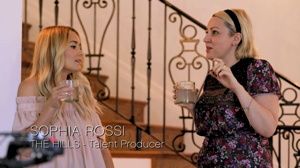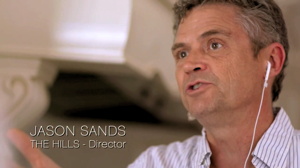Keeping it real:
genre and politics on I Am Cait
by Dan Udy
Having first gained fame for winning gold in the 1976 Olympic decathlon, Caitlyn Jenner—formerly known as Bruce—re-entered the media spotlight in the mid-2000s as the stepfather to Kim Kardashian and a peripheral character in the Reality show Keeping Up With the Kardashians (E! Entertainment Television, 2007-present). After separating from her wife Kris in 2013 and moving to a secluded multi-million dollar home in Malibu, California, she began the process of gender transition. In April 2015 she gave an extensive coming out interview to Diane Sawyer while still using her old name and male pronouns (“Bruce Jenner: The Interview” 2015), and shortly afterwards Jenner revealed her new name and appearance in a cover story for Vanity Fair magazine shot by celebrity photographer Annie Leibovitz (Bissinger 2015). E! Entertainment Television simultaneously announced its upcoming Reality series I Am Cait that would follow her new life as a transgender woman in the public eye. Through the course of the series viewers watched Jenner meet others in the trans community, reveal herself to family members for the first time, and commission a redesign of her luxury home to reflect her new “feminine” style.
 |
 |
| “Bruce Jenner: The Interview” (ABC) | “Bruce Jenner: The Interview” (ABC) |
After being renewed by the network, I Am Cait returned to E! for its second season on March 2, 2016 with an episode titled “Politically Incorrect.” Although season 1 had addressed political issues at various points, such moments fell under the show’s broader focus on Jenner’s journey of self-discovery. In contrast, the season 2 premiere framed upcoming episodes through the lens of tense political conflict, and positioned trans politics at the heart of its season-long story arc. At its opening, Jenner appears in a video diary segment made just after filming had wrapped. In it, she reflects on the season’s main event—a month-long trip across the United States with a group of trans activists and cultural producers. Here she notes the fierce political debates that arose on the group’s tour bus. A handful of clips follow that document the season’s key dramatic moments, before cutting back to one month earlier and the start of the bus trip preparations.
Caitlyn Jenner opens the first episode of I Am Cait Season 2 (“Politically Incorrect”) with a video diary segment looking back on the events that took place.
Since announcing her allegiances to the Republican Party in her Diane Sawyer interview, Jenner has attracted widespread criticism for her comments on passing, same-sex marriage, and welfare. This essay doesn’t seek to simply explore her politics, especially considering that she has made her ideological position repeatedly and patently clear. Instead, it takes her contentious views as a starting point for addressing the complex power dynamic among I Am Cait’s network of participants and producers. Here I focus on how the docu-soap format was politicized by both groups against the backdrop of the 2016 presidential race, and I argue that the show demonstrates a collective form of queer political performance as a result.
The performance of queer politics in Reality TV is hardly new. In 1994, a young gay, HIV-positive Cuban immigrant named Pedro Zamora appeared on season 3 of The Real World (1992-present)—MTV’s seminal Reality series in which a group of strangers are filmed as they live and work together. When later writing on the show, José Esteban Muñoz famously theorized Zamora’s work as a radical moment of queer counterpublicity.[1] [open notes in new window]
In Episode 19 of The Real World: San Francisco, “Love Rules”, Pedro and Sean undergo a commitment ceremony in the Real World apartment (Air date: November 3, 1994). In Counterpublicity: Queers of Color and the Performance of Politics, José Esteban Muñoz describes Zamora’s televisual activism as performing a Focauldian “ethics of the self”, and draws particular attention to the commitment ceremony as ‘a moment of counterpublic theater’ that is ‘like none that has ever been viewed on commercial television (Muñoz 1999, 158)
Two decades later, Laverne Cox followed suit when navigating the demands of producers on season 1 of I Want to Work for Diddy (Vh1, 2006), an Apprentice-inspired competition to find rap mogul P. Diddy’s next personal assistant.[2] Queer roots even go back to the genesis of Reality TV in the PBS documentary series An American Family (1973). As cameras captured a year in the life of the Loud family from Santa Barbara, California, eldest son Lance—a flamboyant, self-deprecating musician who moved to New York to follow his hero, Andy Warhol—quickly became the genre’s first breakout star. The particular mode of queer political performance on I Am Cait, though, is unique in many respects. It draws upon new technological contexts for docu-soap production, new modes of viewer engagement that these technologies have produced, and increased visibility of trans advocates, activists, and public figures over recent years.
 |
 |
The Loud family. Back row (L-R): Kevin, Grant, Delilah, Lance. Front row (L-R): Michele, Pat, Bill. |
Lance Loud is filmed writing a letter in his room at the Chelsea Hotel, New York City. (PBS) |
Representational politics—that is, the notion that political equality can be achieved by increasing the number of queer subjects represented in film and television—is by now a clumsy lens through which to approach media texts, and it is not the approach I use here. Nor, I believe, is it the approach taken by the cast members of I Am Cait. Rather, the group use their visibility as trans subjects on a mainstream TV production as a springboard for more direct forms of media activism. In short, the trans cast members of I Am Cait make activist interventions that extend the work of merely being seen: they talk to and about each other, reflect on the content of the program itself, and point outwards to social justice movements beyond the confines of the show. That this takes place during an election season throws the political nature of their performance into especially sharp relief.
Watching the docu-soap: audience interactions online
When announced in June 2015, I Am Cait was billed by E! as an eight-part “docu-series” that would tell Caitlyn Jenner’s ‘intimate story’ and ‘join “Cait” as she seeks out her “new normal”’ (“Watch the First Promo for Caitlyn Jenner’s New Docu-Series on E!” 2015). The marketing of the show as a “docu-series” signalled an attempt by producers to differentiate the programme from the numerous Reality TV productions also broadcast on E!, such as Keeping Up With The Kardashians. As a regular cast-member on the latter before her divorce from her wife Kris, Jenner often featured in scenes with her family members—most notably in a two-part episode devoted to her coming out, “About Bruce” (2015)—and she continues to make occasional appearances on the show. This decision by producers to distance I Am Cait from other shows on the network, though, is a significant one, and reflects a broader shift among producers of docu-soap programming away from the umbrella term of “Reality TV.”
To speak of Reality TV as a coherent genre is challenging, if not impossible. As Annette Hill writes, it is ‘a moving target’ that ‘resists a single identity, occupying multiple positions for different groups of people, in various regions and cultures’ (Hill 2014, 9). Its only requirement is that its participants appear as themselves in unscripted—but not necessarily unplanned—situations. The sub-genre of the docu-soap, though, has its own distinct trajectory, and shows such as Keeping Up With the Kardashians, Jersey Shore and The Real Housewives have now proliferated through international syndication and franchising to dominate broadcast schedules across the globe. In this essay I focus specifically on the docu-soap, due to its adoption of elements from the earlier documentary genre of Cinéma Vérité. Its relationship to this precursor is a fragile one and results in unique modes of audience behavior. That is, docu-soap viewers are now actively involved in teasing out the separate elements of “documentary” and “soap” in the shows they watch, and the rise of Web 2.0 platforms has enabled this work to take place. As a consequence, these new viewing practices now feed back to shape the production and marketing of docu-soap shows, and are particularly evident in the case of I Am Cait.
 |
 |
 |
 |
 |
International franchising and syndication of docu-soap shows. |
Since the docu-soap exploded into public consciousness with The Real World, it has provoked unease among viewers through its indeterminate place between documentary “fact” and entertainment “fiction.”[4] Although its participants are undoubtedly real, their interactions and behaviors may be influenced by footage edits, producer demands, or a combination of the two. Annette Hill has returned to this formal ambiguity and its effects on viewers throughout her work on Reality TV, and she grounds her observations in a wealth of participant-based research. In Restyling Factual TV: Audiences and News, Documentary and Reality Genres she describes how ‘viewers do not experience factual genres in isolation but as part of a chaotic mix of factuality’ (Hill 2007, 2), and she later notes that ‘a queasy feeling’ is now ‘a feature of audience engagement with the genre’ (Hill 2014, 58).[5]
In the mid-2000s, MTV’s “real-life” dramas Laguna Beach: The Real Orange County (2004-2006) and its spin-off The Hills (2005-2009) compounded the formal ambiguity of the docu-soap. Both shows focused on a cast of real affluent teenagers and young adults in southern California, yet indicated a meticulous production process through multiple camera angles, a range of shot types, and flattering lighting. Unlike the Vérité-influenced style of The Real World, producers of Laguna Beach and The Hills instead appeared to take their cues from Hollywood; that the cast were often evasive when questioned about production methods only added to the shows’ mystique. It was not until the end of the final episode—in which a pan out reveals stars Kristen Cavallari and Brody Jenner to be standing on a movie set—that the artifice of both programs is acknowledged, and only recently have cast members revealed how events were staged for the camera.[6] The appeal of Laguna Beach and The Hills for MTV’s young target audience rested on their particular mix of generic forms, and built upon the success of the teen drama series The O.C. (Fox, 2003-2007). Not only did they promise an insight into the community that inspired Fox’s hit series, but they also adopted the latter’s episodic plot structure and co-opted its locations and production techniques. As such, producers capitalized upon audience investment in an already popular fictional program, and amplified this effect by claiming, at least implicitly, that the drama among cast members was all “real.”
 |
 |
 |
 |
The Hills: That Was Then, This Is Now (MTV, August 2nd 2016): to mark the 10th anniversary of the show’s premiere, former star Lauren Conrad was filmed in conversation with members of the production team discussing how plotlines were developed and events were edited and/or staged. In the one-hour special viewers were also shown behind-the-scenes footage and Conrad’s original Laguna Beach audition. |
|
The explosion of social media platforms and user-generated web content at the same time as MTV’s new wave of Reality programming, I argue, enabled web users to decipher the new types of media on their screens. In turn, the discursive possibilities of Web 2.0 paved the way for a new relation between audiences and producers. As viewers encountered unsettling hybrids of real life and fiction, they began to unpick the truth claims of such shows. A decade later, cynicism now drives the reception of docu-soap programming by web-savvy viewers. Gossip blogs and social media networks provide platforms for them to investigate the purported “realness” of Reality television and distinguish genuine events from those instigated by production for entertainment value.
For example, journalist Mariah Smith’s column “Keeping Up With the Kontinuity Errors” for the former Gawker Media blog Jezebel uses social media posts and paparazzi photographs to painstakingly decipher the actual filming dates for scenes in Keeping Up With the Kardashians. Unsurprisingly, it transpires that the supposed chronology of events in the show often fails to correspond to the order in which they were actually filmed, and cast members often feign feelings of anticipation for what has already taken place. “Keeping Up With The Kontinuity Errors” is one of many blogs that work to such effect [see images below]:
- “Reality Steve” provides spoilers for The Bachelor and The Bachelorette,
- “Faux Reality Entertainment” exposes the inner workings of The Real Housewives franchise, and
- “Bitch by Bravo” reveals behind-the-scenes events across multiple Bravo docu-soaps.
Alongside this user-generated content, web-based gossip outlets such as TMZ and Radar Online also provide scoops on Reality stars and the shows in which they feature. Crucially, social media invariably function as the “evidence” that guides these investigations, and as such, they provide both a means of accessing the documentary “real” and also a platform for disseminating uncovered truths.
Blogs about the "real" in Reality Television.
From “docu-soap” to “docu-series”
A noticeable shift in docu-soap production methods took place through the early 2010s in response to this widespread cynicism among Reality TV audiences. Producers began to slowly undo the meticulously constructed “Reality” of docu-soap shows by incorporating behind-the-scenes footage that reveals elements of the production process. This trend can best be understood as a return to the principles of Cinéma Vérité (i.e. ‘an attempt to strip away the accumulated conventions of traditional cinema in the hope of rediscovering a reality that eludes other forms of filmmaking’, as theorized by Stephen Mamber (Mamber 1974, 4)). Bill Nichols’ division of documentary into six modes—poetic, expository, observational, participatory, reflexive, and performative—is useful for framing this phenomenon, as older and newer docu-soap styles can be positioned across different categories. While earlier docu-soaps mixed observational and participatory modes through fly-on-the-wall footage and interview segments, recent production styles have moved towards the reflexive mode that ‘calls attention to the assumptions and conventions [of] documentary filmmaking’ (Nichols 2010, 31). In line with these changes, the presentation of shows as “docu-series” marks attempts to re-orient the docu-soap away from Reality television and its implications of trash, exploitation, and entertainment. The guiding definition of “docu-soap,” however, is a serial narrative structure, and as such the moniker of “docu-series” reflects little or no change in production beyond an increased degree of self-reflexivity.
 |
|
| Untucked, a YouTube companion series to Logo’s Rupaul’s Drag Race, documents contestants backstage in between taped segments of the main show and features regular interactions with the production crew. | |
 |
 |
| During Episode 6 of I Am Cait Season 2 (“Guess Who’s Coming to Dinner?”), Jenny Boylan visits Jenner in her hotel room and notices the camera used for her video diary segments. Boylan then proceeds to use the equipment, and footage from the confessional camera is interspersed with footage documenting the pair filming themselves. | |
Any changes in production style that do take place are relatively minute, and include a subdued soundtrack, soft lighting and multiple camera angles—often in close-up—for talking head interviews. Prior to I Am Cait, Lindsay—an eight-part series broadcast on the Oprah Winfrey Network (OWN) in 2014—demonstrated an early use of these production effects. The show chronicled Lindsay Lohan’s re-adjustment to life after a court-mandated rehabilitation program and followed the hard-worn tropes of docu-soap programming, yet it also featured clashes between Lohan and filmmakers as she proved increasingly difficult to work with. Lindsay was marketed by OWN as a “docu-series,” no doubt to position it more effectively within the Winfrey’s personal brand of authenticity, sincerity, and self-improvement; in this respect it revealed OWN’s ideological attachment to “documentary” as a means of validating “serious” content.[7]
 |
 |
 |
 |
| Lindsay and I Am Cait: In “docu-series” programmes talking head interviews are filmed using multiple camera angles and varying degrees of close-up. | |
In the case of I Am Cait, early episodes indicated producers’ more explicitly political alignment to “documentary.” Although Jenner—a co-producer on the series—has since scaled back her ambitious rhetoric, she reiterated throughout the first season that her wish was to educate viewers and ‘raise awareness,’ thus bringing about social change. The fraught relationship between I Am Cait and its sister program, though, makes the fragility of this rebrand especially acute. For example, in a post from 16th February 2016, Mariah Smith (KUWTKE) deduced that a scene from Keeping Up With The Kardashians was in fact originally shot for I Am Cait (Smith 2016). [See image below]
 |
Although this doesn’t negate the political potential of I Am Cait, the interchangeability of both shows proves that an apparent shift from “docu-soap” to “docu-series” is at best a producer-led branding exercise. While the label of “docu-series” may provide more direct signposting towards political content, I argue that the docu-soap genre already provides ample scope for political work. As the second season of I Am Cait demonstrates, this labor can be performed in simultaneous opposition to and compliance with the show’s producers, and provides numerous avenues for queer intervention.
The difference in colour grading and brightness between these two Keeping Up With the Kardashians scenes – both filmed outdoors within a few days of each other and in nearby locations – indicates that the former was originally shot for I Am Cait.





















